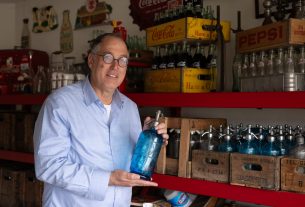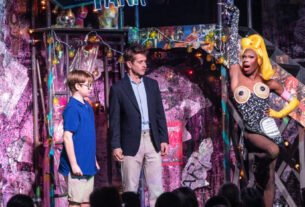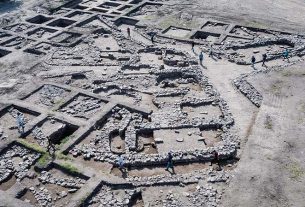(New York Jewish Week) — When a small group of people convened next to an inconspicuous plaque steps from the entrance to the Staten Island Ferry’s Whitehall Terminal earlier this week, they weren’t there to catch a boat leaving the island.
Instead, they had come to the southern tip of Manhattan to celebrate a ship that had arrived on its shores centuries before.
The gathering on Wednesday was the 369th anniversary of an event most New Yorkers don’t know about, let alone celebrate: the arrival of the first Jewish community to the United States in 1654. That lack of awareness is exactly what Howard Teich, the founding chair of a group called the Manhattan Jewish Historical Initiative, hopes to change.
That year, a group of 23 Sephardic Jews arrived on the shores of New Amsterdam, the Dutch colony located on the island. In the centuries since, the city and its image have been shaped in no small part by its Jewish denizens — from Emma Lazarus to Ed Koch to Nora Ephron.
In hosting the “Landing Day” ceremony, Teich’s ultimate goal is for Jews in the city with the world’s largest Jewish population to gather every year to celebrate their culture and accomplishments.
“We just have to change the narrative of the community right now,” Teich told the New York Jewish Week, adding that he felt Jewish communal discourse was at times overly focused on fear and division. “We’ve got to spread a positive message of who we are, what we’ve accomplished, how we’ve worked with other people, what we’ve started, the difference we’ve made in the time we’ve been here and, really, what America has meant to us as a people.”
Wednesday’s ceremony was held at Peter Minuit Plaza, next to a flagpole adorned with a plaque that reads: “Erected by the State of New York to honor the memory of the twenty three men, women and children who landed in September 1654 and founded the first Jewish community in North America.”
Donated by the State of New York, it is called the Jewish Tercentenary Monument and was put up in The Battery in 1954 to mark the 300th anniversary of the Jews’ arrival. That year, events were held for months across New York and the United States to celebrate, but in the decades since, there have only been a handful of gatherings at the site. None of the events and pronouncements associated with a Landing Day celebration in 2004, for the 350th anniversary, took place near the monument.
Teich aims to revitalize the celebration, and he hopes an annual event will take place at the plaza each fall.
“Now is the time,” he said. “[This ceremony] was supposed to show the positive of a community that’s really excelled in freedom. It’s incredible what’s been established in America and in New York in particular as a center of American Jewry to a large extent. That’s what I want to see celebrated.”
For Wednesday’s ceremony, Teich partnered with the Battery Conservancy, the New York Board of Rabbis and dozens of other Jewish and historical organizations across the city. Local and state politicians were also in attendance, including City Councilmember Gale Brewer, State Assembly Members Rebecca Seawright and Alex Bores, and State Comptroller Thomas DiNapoli. Elias Levy, the Jewish consul general of Panama in New York, was also present.
“I want our monuments to come alive,” Warrie Price, the president of the Battery Conservancy, said in a speech. “I ask all of you to make this monument as relevant as it was in 1954, because its values and what it symbolizes are as true today as ever. We are still a landing site. We will never stop being a landing site. As New Yorkers and as a people of consciousness, we care and we will find the solutions to continue being a landing site.”
Support the New York Jewish Week
Our nonprofit newsroom depends on readers like you. Make a donation now to support independent Jewish journalism in New York.
Along with speeches and music, which included Ladino and Hebrew versions of “Shalom Aleichem” and “Ein Keloheinu” from Rabbi Cantor Jill Hausman; a klezmer clarinet performance from the musician Zisel; and a rendition of “Somewhere Over the Rainbow” from singer Hannie Ricardo, attendees also heard a short history of the Jewish arrival in New Amsterdam from Bradley Shaw, a historian at the Lower East Side Jewish Conservancy.
Like so many immigrants to New York City who came after them, the Jews who landed in Manhattan in 1654 were fleeing persecution. In this case, they were escaping the Portuguese, who had conquered the Dutch colony of Brazil where the Jews had been living and instituted the Catholic Church’s Inquisition.
As it happens, just weeks before the group of 23 landed, three Ashkenazi Jews — Jacob Barsimson, Solomon Pietersen and Asser Levy, who was the New World’s first kosher butcher and Jewish homeowner — had come to New Amsterdam from Europe. Those three men greeted the group. When Peter Stuyvesant, the Dutch director-general of New Amsterdam, originally rejected the new refugees — saying he wanted to establish a colony solely for Dutch Reformed Christians — Levy advocated on their behalf.
“The question I have is, did they have a minyan?” Shaw said, referring to a traditional Jewish prayer quorum of 10 men. The group had arrived just before Rosh Hashanah.
“The answer is, I really don’t know,” he said. “But that said, they might have. They had the four men from the boat and the three that were here. And of the children, there might have been one or two that were bar mitzvahed,” or over 13 years old.
With Levy’s help, along with urging from the Dutch West India Company, which counted many Sephardic Jews among their investors, the group stayed. Eventually, they established the Mill Street Synagogue, the first congregation in the United States. It eventually became Congregation Shearith Israel, or the Spanish and Portuguese Synagogue, whose building is now on West 70th Street.
According to the most recent estimates, the five boroughs are now home to more than 1 million Jews.
“Usually you come to a strange place and the first thing you look for is a synagogue,” said a woman at the ceremony who wished to remain anonymous, and who did not know the history of the Jews’ arrival before the event. “I can’t imagine what it would be like to be the first ones to arrive.”
Teich wants to build momentum for the 400th anniversary of Landing Day — just 31 years away.
“There’s a real continuity that we need to appreciate,” he said. “That’s who we should be as a people — we have 5,000 years of history and nearly 400 here. It’s quite something.”




